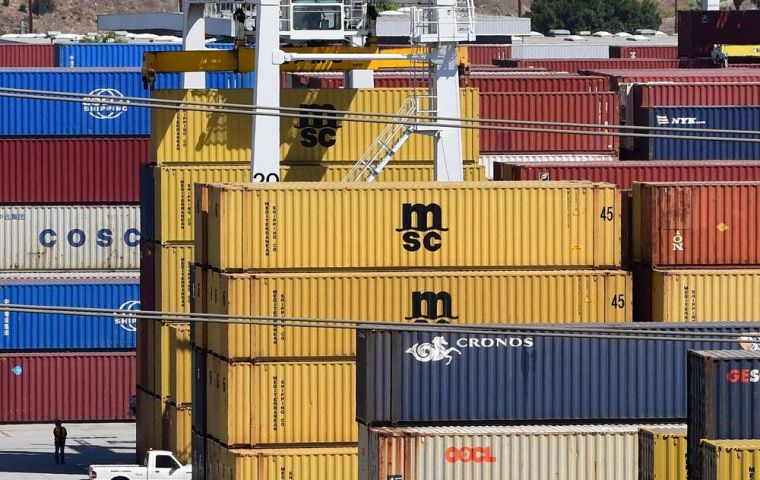MercoPress. South Atlantic News Agency
Global production of shipping containers piles up at major ports because of lack of demand for goods
 The decline marks a sharp reversal from two years ago, when container manufacturing boomed in response to a pandemic-induced surge in demand for physical goods
The decline marks a sharp reversal from two years ago, when container manufacturing boomed in response to a pandemic-induced surge in demand for physical goods Global production of shipping containers has fallen significantly as demand for goods sank following the easing of pandemic restrictions, leaving the corrugated steel boxes piled up at major ports.
Figures provided to the Financial Times by Drewry, a maritime research consultancy, show that production of 20-foot equivalent units — the industry’s standard size for a container — fell 71 per cent from 1.06mn to 306,000 between the first quarter of 2022 and the same period this year.
The decline marks a sharp reversal from two years ago, when container manufacturing boomed in response to a pandemic-induced surge in demand for physical goods which led to a shortage of the rectangular boxes.
However, demand for exports has waned since restrictions eased and economies have reopened, leaving the shipping industry with a surplus of containers that threatens to overwhelm ports in China, where up to 95 per cent of the world’s boxes are produced.
AP Møller-Maersk, one of the world’s largest shipping conglomerates, has said it is halting production of dry containers until at least 2024, though it said it might resume building 20ft boxes sooner than its larger 40ft versions as the demand for the former appeared to be more resilient.
Anne-Sophie Zerlang Karlsen, Maersk’s head of Asia-Pacific customer delivery, told the FT the company was also seeking to sell or scrap more of its older boxes to take advantage of the glut.
The drop-off in demand has hit manufacturers hard. Profits at China International Marine Containers, one of the country’s largest producers of the boxes, plunged 91 per cent year on year to Rmb160mn ($23mn) in the first three months of this year.
Sales of standard containers dropped 77 per cent during the period, the Shenzhen-headquartered company said, blaming a “continuous decline in the container trade and an insufficient demand for new containers”.
Profits at Cosco Shipping Development, the container manufacturing arm of state-owned shipping group Cosco, dipped 71 per cent in the first quarter of this year to Rmb398mn.
World Trade Organization economists believe export growth will stutter for the duration of this year, suggesting that demand for containers would remain weak. The latest WTO forecasts, out last month, estimate a boost to trade in goods of just 1.7 per cent this year — down from 2.7 per cent growth in 2022.
Container shipping lines are already having to cope with a severe decline in profits following a record period for earnings during Covid-19 lockdowns, when supply chain disruptions — along with the boom in demand for goods — drove up the cost of shipping.
The boom left shipping groups rushing to stock up on new containers after pandemic-induced bottlenecks at many ports led to shortages of boxes in place to ship goods from Asia.
In 2021, global production reached 7.1mn standard-sized containers, more than double the output in 2020, according to Drewry.
Now demand has fallen so greatly that port owners in the region face the fresh problem of having to find space for record volumes of unused boxes.
Stockpiles are now at record levels across the Asia-Pacific region, Karlsen said, adding that “massive amounts” of containers were expected to continue to pile up in ports in the region throughout this year.
She said the “lion’s share” of the units in storage were 40ft-high cube containers largely used in the Asia-Europe and Asia-US markets, resulting from weaker demand on those routes. At the same time, over the past month there had been a shortage of 20ft dry containers, which were in demand in markets such as Latin America and Africa, she added.
The availability of boxes at Shanghai, the world’s largest container port, has been higher this year than during the spring lockdown of 2022, according to analysis firm Container xChange.
However, Michael Fitzgerald, deputy chief financial officer at the Hong Kong-listed shipping group Orient Overseas Container Line, said earlier this month that the glut at Chinese ports had eased “over the past few weeks.”




Top Comments
Disclaimer & comment rulesCommenting for this story is now closed.
If you have a Facebook account, become a fan and comment on our Facebook Page!